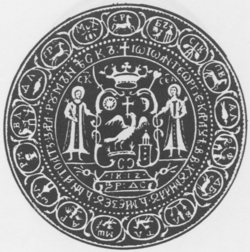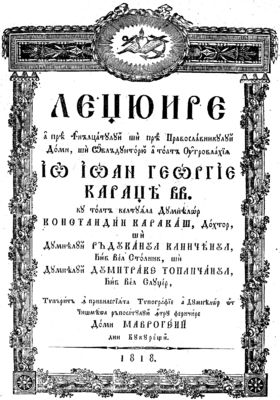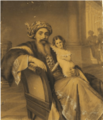John Caradja facts for kids
Quick facts for kids John George Caradja |
|||||
|---|---|---|---|---|---|

Italian-school portrait of Caradja, ca. 1819
|
|||||
| Prince of Wallachia | |||||
| Reign | 27 August 1812–11 October 1818 | ||||
| Coronation | 24 December 1812 | ||||
| Predecessor | Constantine Ypsilantis | ||||
| Successor | Alexandros Soutzos | ||||
| Chairman of the Greek Central Government in the Peloponnese | |||||
| Reign | 9 January 1822–c. February 1822 | ||||
| Predecessor | none | ||||
| Successor | none (Alexandros Mavrokordatos as President of the Executive) |
||||
| Born | Ioanni Georgiou Karatzas (Ἰωάννης Γεωργίου Καρατζάς) 1754 Istanbul, Ottoman Empire |
||||
| Died | 27 December 1844 (aged 89 or 90) Athens, Kingdom of Greece |
||||
| Burial | 29 December 1844 Saint George Church of Kolokynthou |
||||
| Spouse | Eleni Skanavi | ||||
| Issue |
|
||||
|
|||||
| House | Karatzas (Caradja) | ||||
| Father | Georgios Karatzas | ||||
| Mother | Sultana Mavrocordatos-Karatzas | ||||
| Religion | Greek Orthodox | ||||
| Occupation | Diplomat, translator, theatrical promoter | ||||
| Signature |  |
||||
John George Caradja, also known as Ioan Gheorghe Caragea, was a Greek prince from the Phanariote family. He ruled Wallachia (a region in modern-day Romania) from August 1812 to September 1818. He was the second and last member of the Karatzas or Caradja family to become Prince of Wallachia.
Caradja's time as ruler happened when Phanariote influence was very strong in the Danubian Principalities. This period was known for political problems and outside interference. He became prince with support from the Austrian Empire and by paying a lot of money, which he planned to get back through taxes.
His rule began as Wallachia was recovering from a Russian occupation. He was known for making strict laws, including Legiuirea lui Caragea ("Caradja's Law"). He also faced a terrible outbreak of the plague, which became known as "Caragea's plague".
After his rule, Caradja left Wallachia in 1818. He lived in Switzerland and Italy, supporting the Greek War of Independence. He later returned to live in the newly formed Kingdom of Greece. He was often seen negatively in Romanian stories, but also praised for some of his actions.
Contents
Who Was Prince John George Caradja?
Early Life and Family History
The Caradja family has a long history, possibly coming from places like Italy, Turkey, or Greece. The name "Caradja" is Turkic and means "roe deer." Some historians believe the family might have been Hellenized Pechenegs (an ancient nomadic group).
John George Caradja was born in Istanbul in 1754. His father, Georgios Karatzas, was a very important official called the Great Dragoman. His uncle, Nicholas, was also a Great Dragoman and even a Prince of Wallachia before him. Another uncle, Joannicius, was the Patriarch of Constantinople, a top religious leader.
Not much is known about John's early life before he became Great Dragoman at age 55. He worked as a translator for peace talks during the Habsburg–Ottoman War in 1790. He also translated plays by the Italian writer Carlo Goldoni.
He married Eleni Skanavi, whose aunt was married to another Prince of Wallachia, Nicholas Mavrogenes. John and Eleni had five children. Their daughter Rallou became famous for helping start modern Greek theater. Another daughter, Roxani, married Michael Soutzos, who later became Prince of Moldavia.
Becoming Prince of Wallachia
The Caradja family became powerful during a time when the Ottoman Empire was struggling. Wallachia and Moldavia were under Ottoman rule, but also influenced by the Habsburg monarchy and the Russian Empire.
John Caradja served as Great Dragoman twice. This was a very important job, acting as a chief interpreter and diplomat for the Ottoman Empire. He became Prince of Wallachia on August 27, 1812. He reportedly paid a huge amount of money to get the throne, which he planned to get back from the people of Wallachia through taxes.
When he arrived in Bucharest, the people were happy because it meant the end of the Russian occupation. However, Caradja quickly showed his strictness. He punished those who had supported the Russians. He also gave many important jobs to his Greek friends and family, often in exchange for money. This system of collecting money angered many people in Wallachia.
Caradja moved into a temporary palace in Bucharest after his official palace burned down. He was known for being a harsh judge. A visitor in 1813 noted his favoritism and how he even punished a boyar (a noble) for supposedly insulting his daughter Rallou.
Life During His Rule
The Plague and Its Impact
Soon after Caradja became prince, Wallachia was hit by a terrible outbreak of the Eastern plague. This plague, known as "Caragea's plague", lasted from June 1813 to April 1814 and was one of the deadliest in the country's history.
Caradja tried to stop the plague by ordering strict quarantines. He expelled beggars from Bucharest and closed public markets. He even issued a formal curse on anyone who didn't follow the rules. However, the plague still caused many deaths. Some reports say 70,000 people died across Wallachia, with 20,000 in Bucharest alone.
The Prince himself survived by staying isolated in Cotroceni Monastery. Some people blamed him for the plague, saying his Greek entourage brought it. But other reports suggest he did his best to control it, even though doctors often fled the city.
New Laws and Taxes
Despite the plague and economic problems, Caradja introduced new tax policies. These were seen as very harsh by the people. He tried to increase the number of families who had to pay taxes and reduced the number of people who were exempt.
He also put pressure on rural communities to give up land. This led many Wallachians to move to neighboring regions to escape the heavy taxes. However, Caradja also tried to help local producers by changing how grain was measured for export, which made food more affordable for locals.
Caradja also worked to improve relations with Austria. He sent money to the Austrian Chancellor, Klemens von Metternich, to get updates on world politics. He also helped the Ottoman Empire by punishing people seen as responsible for losing land in the recent war.
Caradja's Law: Legiuirea lui Caragea
In 1818, Caradja published an updated set of laws for Wallachia, known as Legiuirea lui Caragea ("Caradja's Law"). This law tried to combine old Byzantine law with local customs. It was seen as an attempt to modernize the legal system.
The law aimed to bring more equality before the law and focus on individuals' rights. However, it also increased the duties that peasants had to perform, fixing forced labor (corvée) at 12 days a year. It also limited women's inheritance rights, favoring male children.
One interesting part of the law was that it only listed death as a punishment for three major crimes: murder, robbery, and counterfeiting. However, the Prince could still decide to apply capital punishment for other reasons. For example, Caradja famously pardoned the outlaw Iancu Jianu.
Cultural Changes and Education
Caradja was interested in cultural reforms. He supported education and in 1814, he set up a commission to reorganize the princely academy. This school was important for promoting learning.
At first, the academy only taught in Greek and Church Slavonic (an old language). This caused arguments with Romanian nobles who wanted classes in their native language. In December 1817, Caradja finally agreed to create a Romanian-language school within the academy. This project was led by Gheorghe Lazăr, an engineer who encouraged Romanians to be proud of their heritage.
Caradja's daughter, Rallou, also played a big role in culture. In late 1817, she opened the Cișmeaua Roșie theater in Bucharest. This was the first professional Greek-language theater group in the Romanian lands. Caradja himself enjoyed the arts and continued to translate plays by Carlo Goldoni.
Leaving Wallachia and Later Life
The Escape
By 1817, Caradja was facing problems with the Ottoman Empire because he couldn't meet their financial demands. He also became involved in secret talks with groups supporting Greek independence.
On September 29, 1818, Caradja and his family secretly fled Bucharest. They pretended to go on a leisurely trip but instead headed for Kronstadt in Transylvania (part of the Austrian Empire). They were accompanied by 300 guards and reportedly carried a huge fortune with them.
The Austrian authorities allowed them to pass, using forged papers. Caradja and his family then traveled to Switzerland, staying in Geneva for about six months. They were known for their lavish lifestyle and expensive clothes.
Supporting Greek Independence
Caradja's escape angered the Ottoman Sultan. The Sultan issued a decree limiting which Greek families could hold high offices. Caradja's properties in Istanbul were taken by the state.
From his exile, Caradja became a strong supporter of the Greek War of Independence. He lived in Pisa, Italy, and used his large fortune to fund the Greek nationalist movement. He sent money to important Greek fighters.
In 1822, the Greek rebels in the Peloponnese even elected Caradja as the chairman of their temporary government. However, this plan didn't fully happen, and he returned to Pisa. He continued to support Greek leaders like Ioannis Kapodistrias, who later became Greece's governor.
Life in Greece
Caradja eventually settled in Athens, Greece, in 1830. He lived a more private life, but still welcomed important visitors like Otto of Wittelsbach, the first King of Greece.
He continued his cultural interests, publishing his translations of Goldoni's plays. He also helped his daughter's friend, Costache Aristia, set up the Philodramatic Society of Athens, which supported theater.
John George Caradja died in Athens on December 27, 1844, at the age of 89 or 90. He was buried in Saint George Church of Kolokynthou, which he had helped build.
Legacy and Impact
A Mixed Reputation
In Romanian history, John George Caradja often has a negative image. He is sometimes called the "great predator" because of his harsh taxes and how he collected money. There's even a Romanian saying, "thefts as in Karadzas' time," which shows how people remembered his rule.
However, some historians also see him as a prince with a high level of culture. He was praised for his efforts in education and for supporting the arts. His translations of plays were important for Greek culture.
Influence on Romanian Culture
Caradja had an indirect but lasting impact on Romanian culture. After his daughter Rallou left Wallachia, her theater was used for the first-ever stage performances in Romanian. This was a big step for Romanian theater and literature.
His reign also inspired many Romanian writers and artists. For example, the novel Ciocoii vechi și noi ("Upstarts Old and New") by Nicolae Filimon describes the Caradja era. He also appears as a character in Romanian films and plays, often in adventure stories.
The Caradja family continued to be important after John's death. His sons led different branches of the family, with some descendants serving as diplomats and scholars.
Images for kids
-
"Postelnic Andronache begging Prince Caradja for forgiveness", scene from Nicolae Filimon's Ciocoii vechi și noi
-
Aimée Iacobescu as Rallou Karatza, hugging Florin Piersic during filming for Haiducii lui Șaptecai











